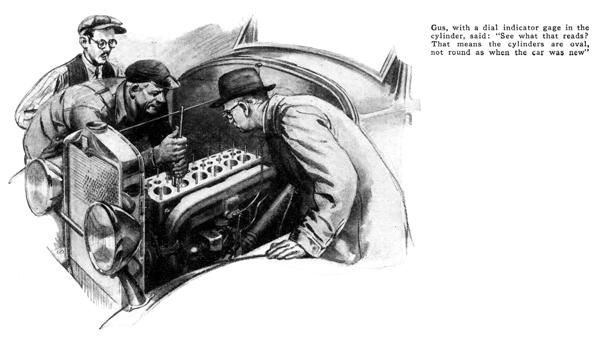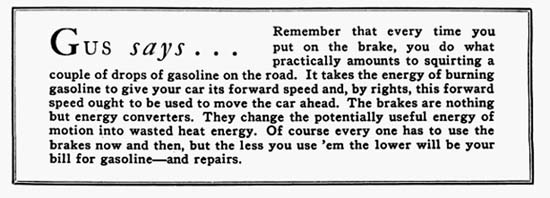January 1932
HOW TO FIT NEW PISTON RINGS
by Martin Bunn

"I'm all through trying to repair automobiles," said Mr. Penny disgustedly as Joe Clark swung open the door at the Model Garage and his partner, Gus Wilson, smiled a greeting.
"Last job didn't turn out so good, eh?" suggested Gus.
"To tell the truth, Gus," confessed Penny, removing his hat and absent mindedly scratching the top of his bald dome, "as an auto mechanic, I fear I'm a good schoolmaster."
Penny spent his days pounding history into boys and girls at the local high school.
"I thought I'd economize by doing my own repair work," he went on. "The motor seemed to be getting weaker and weaker and it used a tremendous quantity of oil, besides starting hard and continually fouling spark plugs. I'd read somewhere that those symptoms meant that the piston rings were worn out."
"You put your finger on the trouble, at any rate," Gus interrupted encouragingly. Then what did you do?"
"I suppose I should have come to you for new rings," said Penny, "but a doctor's bill came in that week and I thought I could save a little by getting the rings from a cut-rate mail order house. It took them four days to get here and then it took me all day Saturday and Sunday and all of my spare time for the better part of a week to install them. And now it's worse in every way than it was before! What did I do wrong?"
"I can make a durn good guess," Gus grinned,” but guessing is bum business in the auto game. Stop around after school tomorrow and I'll have her opened up so we can find out what's wrong."
When Penny arrived a few minutes after three the next day. Gus took him over in the corner where his car was parked. The cylinder head had been removed the oil pan was off, and two of the pistons lay on a bench near by.
"Now," said Gus as he picked up a cylinder bore gage of the dial indicator type, watch this and see what happens."
He carefully started it down the bore of one of the cylinders from which the piston had been removed. The threadlike hand of the dial indicator spun round and then trembled back and forth within a narrow space on the dial as the gage moved the last inch to the halfway mark.
"See where the hand stands now?" he said and then he turned the gage around about ninety degrees so that it measured the bore cross-wise instead of from front to back. Now see what it reads," he said as the needle swung around over five divisions.
"What does it mean?" Penny asked, frankly puzzled.
"It means that the cylinders are worn oval instead of being true round as they were when the car was new.
"Everybody knows you can't put a square peg in a round hole," Gus explained,” but lots of motorists think they can put round piston rings in egg-shaped cylinders and get good results. How can piston rings prevent the escape of gas or the flow of too much oil to the top of the cylinder if the rings touch the walls at only two or three spots?"
"It's obvious they can't," said Penny. "Still I shouldn't think a few thousandths of an inch out of round would make as much difference as that."
"You bet it does," Gus declared.” You've got to remember that oil goes through small openings and it doesn't take much oil above the piston to foul spark plugs and cause a lot of carbon and other trouble. Every bit of gasoline vapor that shoots past the loose rings means that much lost power. I actually could hear it hissing by in these cylinders on the compression stroke when I cranked it by hand."
"And I suppose the cheap rings just made it worse," Penny sighed.
"The rings made it worse, yes," Gus replied,” but not because they were poor quality rings. They are good rings, but not for these pistons. They fit much too loose in the ring slots. There's not much good in having rings that fit the cylinder walls all the way round if they don't also make a good fit in the slots. If you can wobble 'em up and down in the slots, lots of gas will sneak past by going behind in the slots."
"Anything else the matter?" Penny asked. "I noticed myself that the pistons seemed to be a pretty loose fit in the cylinders. Are they worn out, too?"
"Pistons," Gus explained,” are not supposed to fit tight. If you put a set of pistons in a car that were just enough smaller than the bore of the cylinders to slide up and down easily when oiled, they'd expand and stick tight as soon as the motor warmed up."
"Why should the piston expand any more than the cylinder?" Penny asked.” They both get hot, don't they?"
"Sure," said Gus, "but the piston gets hotter -- it isn't water-cooled and the cylinder is. Furthermore, the top of the piston, the piston head, gets hotter than the bottom edge or skirt. The usual practice is to make pistons tapering, with a lot more clearance at the head than at the skirt. Most of 'em are made with about ten times more clearance at the top than at the bottom.
"The head may be anywhere from eleven thousandths to thirty-seven thousandths at an inch smaller than the cylinder diameter, depending on the make of car. Of course the clearance is in proportion to the size of the cylinder. A big piston needs more clearance than a small one."
"I can see why that should be, easy enough," Penny said." Penny said.” How much is it going to cost me to have this motor fixed? Will I have to have a new cylinder block?"
"I should say not!" laughed Gus.” These cylinders aren't so bad. I think I can fix 'em by honing. Of course if they were 'way out and scored into the bargain, then it would pay to have them reground to a larger size. I can hone and put in oversize pistons and the motor will be as good as new. I'll make sure the pistons run true in the cylinders, too. That's where a lot of amateur auto mechanics go wrong. They don't realize, when they put in new pistons and rings, that there's a chance that the new pistons may not sit straight on the ends of the connecting rods. If they don't and the piston tips either forward or backward the least bit, it'll bind, just as sure as you're born."
"What do you do when you find the piston isn't true?" Penny asked.
"First you check to see whether the piston pin hole is exactly at right angles to the axis of the piston. If it isn't, you may find that the error is just enough to offset the slight kink in the connecting rod itself, and putting the piston on the rod the other way to will make everything jake. If that fails the only cure is to try another piston or else to put a kink in the connecting rod that will make the piston square."
"How do you do that," asked Penny.
"If I didn't have any special tools, I'd do it with a husky hammer and some hardwood blocks. The thing you've got to make sure of is, that you put the kink in the rod in such a way that it won't throw the whole piston off to one side. If you do it'll bind worse than ever. You'll know when you've done that because the big end of the connecting rod won't have any endplay on the crankshaft. There always should be a little."
"Good night!" exclaimed Penny.” This business has more ramifications than the Punic Wars! What else is there?"
"Not so much," Gus grinned.” If the cylinders are round, if the rings fit the cylinder walls and the grooves in the pistons and there is no binding, you'll have things about right. Remember that when the rings get hot they expand and tend to close up the gap at the joints in 'em. The gap ought to be three thousandths of an inch for each inch of the cylinder diameter."
"I wonder," observed Penny,” if I'd have done better to install those spring inner rings instead of trying to put in new rings? They say they'll work even if the cylinders are worn quite a bit. Is that so?"
"No question about it," Gus agreed.” Steel spring inner rings will improve matters a lot when the piston rings lose their tension or are worn too much. They make an old motor act fine -- for a while.
"After all," Gus concluded,” there's nothing can equal a real job that puts the cylinders and pistons and rings back into their original condition as near as possible. So, unless you're an expert, you'll do well to replace rings with new ones from the maker of your car."
END
L. Osbone 2019
